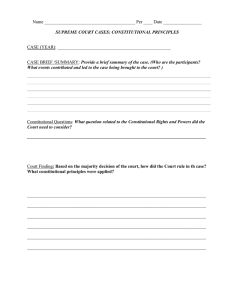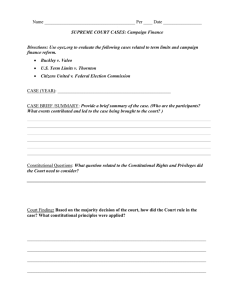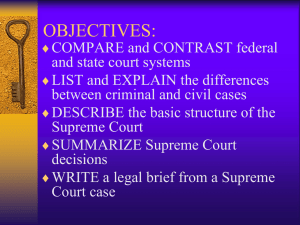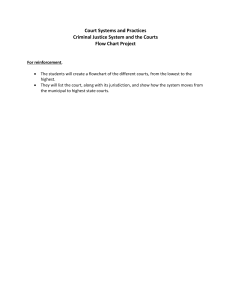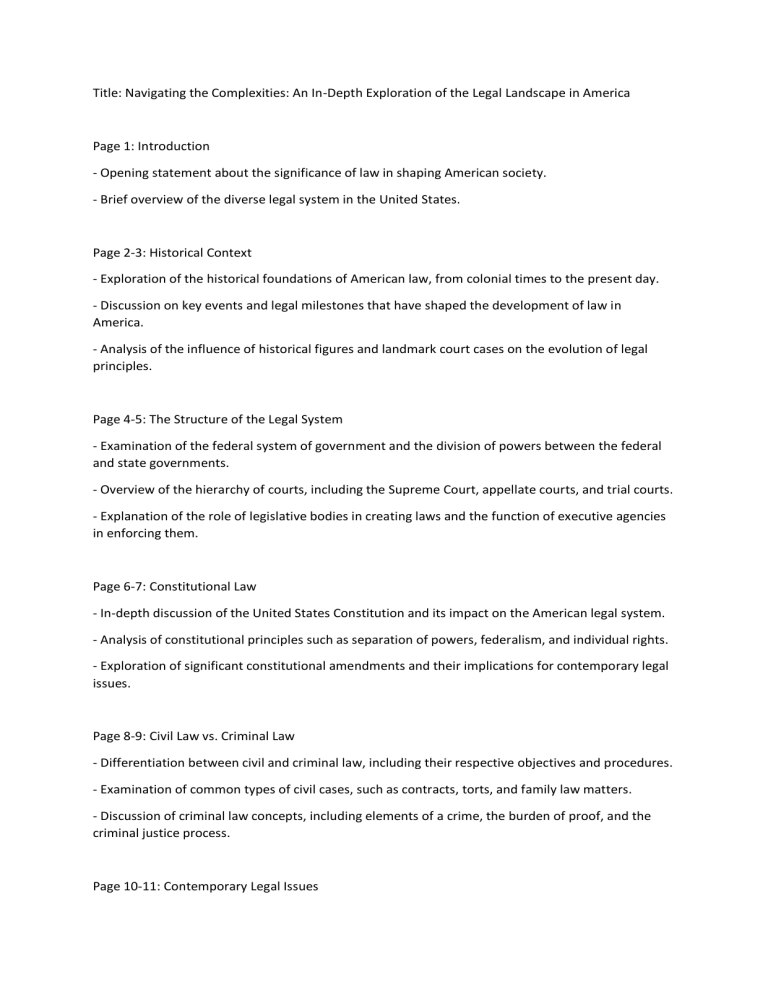
Title: Navigating the Complexities: An In-Depth Exploration of the Legal Landscape in America Page 1: Introduction - Opening statement about the significance of law in shaping American society. - Brief overview of the diverse legal system in the United States. Page 2-3: Historical Context - Exploration of the historical foundations of American law, from colonial times to the present day. - Discussion on key events and legal milestones that have shaped the development of law in America. - Analysis of the influence of historical figures and landmark court cases on the evolution of legal principles. Page 4-5: The Structure of the Legal System - Examination of the federal system of government and the division of powers between the federal and state governments. - Overview of the hierarchy of courts, including the Supreme Court, appellate courts, and trial courts. - Explanation of the role of legislative bodies in creating laws and the function of executive agencies in enforcing them. Page 6-7: Constitutional Law - In-depth discussion of the United States Constitution and its impact on the American legal system. - Analysis of constitutional principles such as separation of powers, federalism, and individual rights. - Exploration of significant constitutional amendments and their implications for contemporary legal issues. Page 8-9: Civil Law vs. Criminal Law - Differentiation between civil and criminal law, including their respective objectives and procedures. - Examination of common types of civil cases, such as contracts, torts, and family law matters. - Discussion of criminal law concepts, including elements of a crime, the burden of proof, and the criminal justice process. Page 10-11: Contemporary Legal Issues - Exploration of current legal debates and controversies in America, such as immigration, gun control, and privacy rights. - Analysis of recent Supreme Court decisions and their impact on American society. - Examination of emerging areas of law, including technology, environmental regulation, and civil rights. Page 12: Conclusion - Recap of key points discussed in the article. - Reflection on the dynamic nature of the American legal system and its ongoing evolution. - Call to action for readers to engage with and contribute to the shaping of law and justice in America. **Page 1: Introduction** Law in America is not merely a collection of statutes and regulations but a cornerstone of the nation's identity and governance. From its inception, the legal framework has played a pivotal role in shaping American society, reflecting its values, aspirations, and struggles. This article embarks on a comprehensive journey through the multifaceted landscape of law in the United States, delving into its historical roots, structural intricacies, constitutional underpinnings, and contemporary challenges. **Pages 2-3: Historical Context** To understand the present-day legal system, one must trace its origins back to the earliest settlements on American soil. From the common law traditions inherited from England to the constitutional conventions that forged a new nation, each era has left an indelible mark on the legal landscape. Landmark events such as the Revolutionary War, the Civil War, and the Civil Rights Movement have shaped legal principles and spurred legislative reforms, illustrating the dynamic interplay between law and societal change. **Pages 4-5: The Structure of the Legal System** The legal system in America is characterized by its complexity and diversity, reflecting the nation's federalist structure and commitment to individual rights. At its core is a hierarchical arrangement of courts, encompassing federal courts established by the U.S. Constitution and state courts governed by their respective legal codes. Legislative bodies at both the federal and state levels enact laws, while executive agencies administer and enforce them, ensuring the rule of law is upheld. **Pages 6-7: Constitutional Law** Central to the American legal system is the United States Constitution, revered as the supreme law of the land. Its enduring principles, including the separation of powers, federalism, and the protection of individual liberties, serve as the bedrock of constitutional law. Amendments to the Constitution have expanded the scope of rights and responsibilities, addressing issues ranging from slavery and suffrage to privacy and equality, while landmark Supreme Court rulings have interpreted its provisions in the context of contemporary challenges. **Pages 8-9: Civil Law vs. Criminal Law** Civil and criminal law represent two distinct branches of the legal system, each with its own set of rules and procedures. Civil law governs disputes between individuals or entities, such as contract disputes, personal injury claims, and family law matters, with the goal of compensating injured parties and resolving conflicts. In contrast, criminal law addresses offenses against society as a whole, prosecuting individuals accused of crimes and imposing penalties to deter future wrongdoing, while safeguarding defendants' rights through procedural safeguards and due process. **Pages 10-11: Contemporary Legal Issues** In the ever-changing landscape of American law, contemporary issues spark debate and litigation, reflecting evolving social norms and technological advancements. From immigration reform and gun control to environmental protection and privacy rights, the legal system grapples with complex challenges that test its capacity for justice and equity. Recent Supreme Court decisions have addressed fundamental questions of constitutional interpretation, shaping the course of law and policy for generations to come, while emerging areas such as cybersecurity and artificial intelligence present novel legal dilemmas requiring innovative solutions. **Page 12: Conclusion** As this article concludes, it is evident that law in America is not static but dynamic, evolving in response to the shifting currents of society and the demands of justice. While rooted in tradition and precedent, the legal system remains adaptable and resilient, capable of addressing new challenges and safeguarding fundamental rights. As citizens and stakeholders, we must remain vigilant in upholding the principles of democracy and the rule of law, ensuring that justice remains the cornerstone of the American experience. Through active engagement and informed discourse, we can contribute to a more just and equitable society, where the promise of liberty and justice for all is realized for generations to come.


